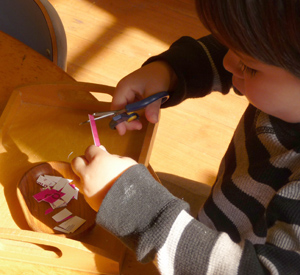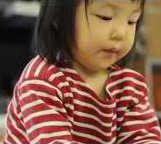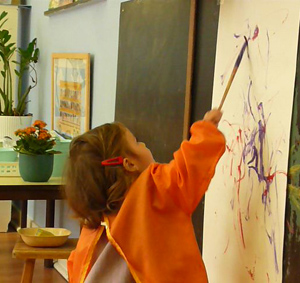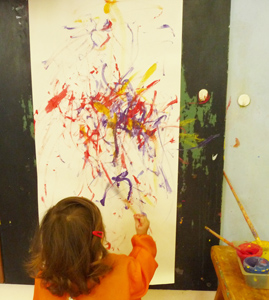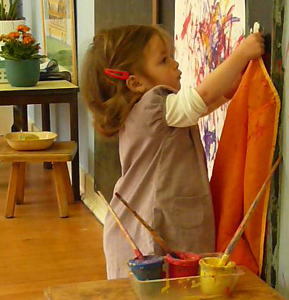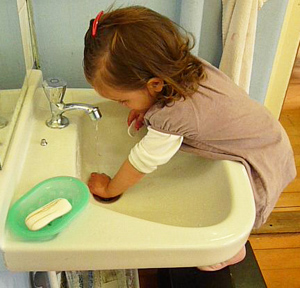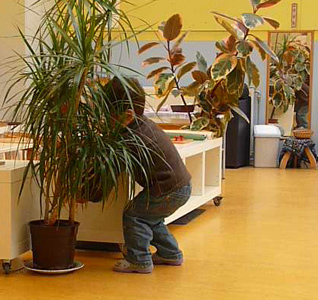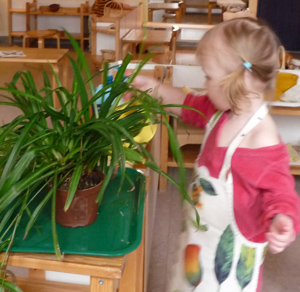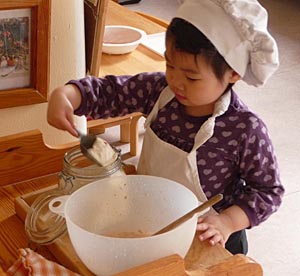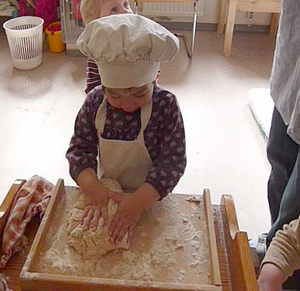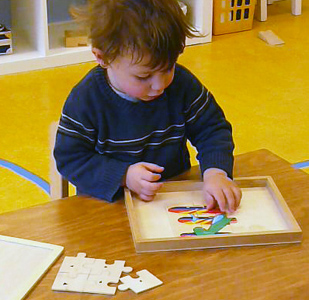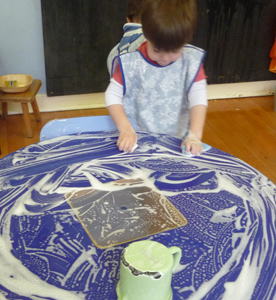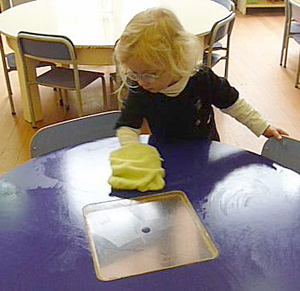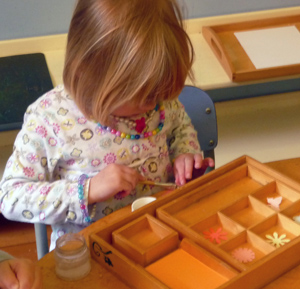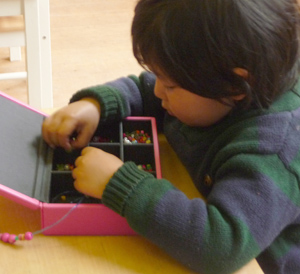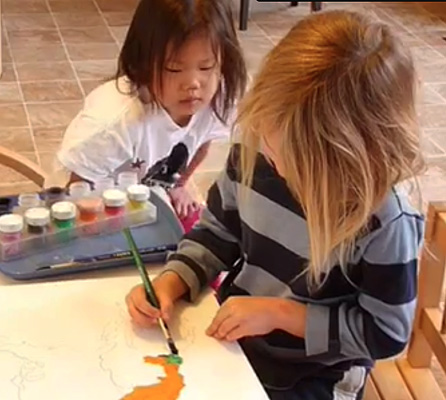Montessori Child Development Stages:
|
|||||
Age 0-3 home page: birth-three
Age 0-1 page: first year Age 1-2 page: second year Age 2-3 page: third year Middle School Human Development Course |
I just can't find the words to say how inspiring this Birth to Three message is. These videos should be required viewing for all teacher training courses. Many children will have a better "growing up" time thanks to you. —Charlene Trochta, founding director of Casa Montessori in Austin, Texas, USA . . .MORE COMMENTS The first essential for the child's development is concentration. |
||||
NOTE On YouTube random videos show up after the one you watch from this site. These are not ours! NOTE Although many of these 2-3 video clips are from Montessori infant communities, we share them for parents to see the amazing potential of their child, and to give ideas of things to do at home. |
|||||
|
|
||||
This child is 2 years old. He is concentrating on carefully cutting the end of a prepared strip of paper. When they are cut the little squares of rectangles are then placed by the child into an envelope. This is the "work." (In a 3-6 class these pieces are sometimes sorted by color and used to make mosaics.) |
This child is only two years old, but because she is allowed to take part in the work of her family it is evident that she feels just as important, just as able to contribute, as the other members of the family. Note the high level of concentration and the careful use of her hands. This video is from a friend in Japan. |
||||
|
|
||||
At 18 months this little girl is learning to paint. She chose the work this morning with no suggestions by an adult. At the moment she does this every day. She is clearly oblivious of the children and adults busy around her. No one interrupted her concentration on this task. |
I watched this child paint continually for 45 minutes. Occasionally she would turn around and watch other children for less than a minute and then return, with deep concentration, to her art. This activity obviously fulfilled a deep need in her. |
||||
|
|
||||
Every unnecessary help is a hindrance to the child's development. (Montessori, MD) As much as she enjoyed painting, she enjoyed putting on, taking off, and hanging up the painting apron. Using an apron helps a child focus on the beginning and end of an activity. It is all important work. |
And now that the painting is finished, apron hung up, paint area clean, she goes to the sink and washes her hands. Every step of this process calls forth logical thinking, planning, problem-solving, and concentration. It ends with happiness and satisfaction. |
||||
|
|
||||
If the adult shows the child how much water to put in a watering can, and how to tell if the soil is dry, a child even as young as this one, 2.5 years of age, can water the plants in the home or in the infant community. Dusting or washing the leaves is also a favorite activity at this age. |
In this infant community small plants are watered by bringing them to a deep tray. This 2.5 year-old waters the plants, returns them to their place, and then cleans up the water on the tray. Notice the special "plant care" apron she is wearing, with a beautiful leaf pattern. It was made by her teacher. |
||||
|
|
||||
This 2.5 year-old is preparing to bake bread. The teacher puts out the exact amount of oil, water, flour, and sugar and each day one of the children prepares the bread for baking. Notice another child in the video peeling eggs in the background; many children working on making the noon meal. |
As she kneads the dough and then cuts it into individual pieces to rise and bake in a muffin tin, a younger child comes along and asks the adult who is watching for the name of everything involved in baking bread. This exploration of language is very typical at this age and the adult gives precise and correct words. |
||||
|
|
||||
Toys or "manipulative materials" are second in importance to including the child in the real work of the community or family. It is such work that has prepared this 2.5 year-old to do this puzzle. First simple 2-piece puzzles are given, two different shapes the same color so the child can focus on the shape and not be confused by color. Then other knobbed puzzles of further difficulty. It is clear that this is not the first time the child has done this particular puzzle, repetition being a great need at this age. |
A child first learns to UNDRESS and practices undressing over and over again. Eventually, in his own time he will learn to DRESS himself. One of the greatest gifts we can give at this stage is to not interrupt the child's attempts, and to give him time. This child, almost 2 years of age, worked for 45 minutes straight removing and putting on her socks. No one interrupted her to give help. The video was taken in Japan in an Infant Community connected with the Montessori teacher training: 0-3 course |
||||
|
|
||||
In a Montessori infant community a child is given precise lessons on table washing a small table, but sometimes a child will take on a giant project of a large lunch table and make a "mess." But no one interrupts this important work when the purpose is valid and if you look carefully you will see a younger child coming up behind this 3-year-old to mop up the water on the floor. |
It is quite common at age 1-3 for one child to begin an activity (such as washing a table) and another to come along and finish it (drying the table). This is different from age 3-6 when the child can, and wants to, complete all of the many steps of an activity from start to finish on his own. This child, age 2.5, has taken it upon herself to dry several tables washed by another child. |
||||
|
|
||||
| This child is 3 years old. She selects a pre-cut (die-cut) shape, carefully dips the tiny brush into the glue and places a line of glue on each flower petal, then glues it to a piece of paper of a contrasting color. Voila—a work of art, and preparation for many gluing projects in future years! | Notice the deep level of concentration and the fine ability with his hands and fingers that is the result of almost 2 years in a Montessori infant community where he was allowed to do many other things, such as sweeping, pouring, washing dishes, etc. —all preparation for ability and concentration. Age: 3 years. |
||||
|
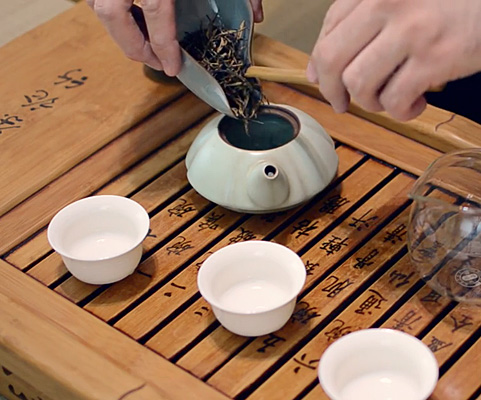 |
||||
| The development of movement and concentration continues in the 3-6 Montessori class and beyond. Respect for concentration is the greatest gift we can give and children are taught how to watch their fellow classmates without interrupting. | The life of the adult in the Montessori world changes forever when she learn, watching children, the value of being mindful, of learning to focus and concentrate on the mind and body acting together. This wisdom is seen in many cultures throughout the ages, as in this tea ceremony: Mindful Tea Ceremony |
||||
SHARING THIS SITE: This site is being used in Montessori teacher training courses at all levels, and by schools to help parents discover the amazing potential of the young child, or to prepare families for future Montessori education. Please feel free to link it to any educational site and to share it. These developmental video clips and the accompanying information is being used all over the world, including the countries of Colombia, Peru, Mexico Russia, Japan, Indonesia, Turkey, Finland, France, Italy, Australia, Albania, Chile, South Africa, China, India, Pakistan, Ireland, Switzerland, Romania, and Canada and more. They are being shared by teachers, doulas, university professors, grandparents, artists, physicians and others. |
|||||
MICHAEL OLAF Montessori information MICHAEL OLAF MICHAEL OLAF Montessori shop BOOKS & MATERIALS MONTESSORI INFORMATION
Updated on May 12, 2022 |
"FIRST MONTESSRI BOOKS" BOOKS The following books in the "First Montessori Books" series contain Birth to Three information: Aid to Life, Montessori Beyond the Classroom The Joyful Child: Montessori, Global Wisdom for Birth to Three AUTHOR'S WEBSITE, Montessori work over the years, art and international blog, SUSAN |
||||
